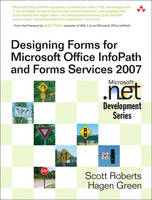
Designing Forms for Microsoft Office InfoPath and Forms Services 2007
Addison-Wesley Educational Publishers Inc (Verlag)
978-0-321-41059-7 (ISBN)
- Titel erscheint in neuer Auflage
- Artikel merken
"Microsoft Office InfoPath represents a revolutionary leap in XML technologies and a new paradigm for gathering business-critical information. I am delighted that Scott Roberts and Hagen Green, two distinguished members of the InfoPath product team, decided to share their experience in this book."
--From the Foreword by Jean Paoli, cocreator of XML 1.0 and Microsoft Office InfoPath
Microsoft Office InfoPath 2007 offers breakthrough tools for gathering, managing, and integrating business-critical information, and creating efficient forms-driven processes. Two longtime members of Microsoft's InfoPath product team have written the first comprehensive, hands-on guide to building successful XML-based solutions with InfoPath 2007.
The book opens with a practical primer on the fundamentals of InfoPath form template design for information workers and application developers at all levels of experience. It then moves into advanced techniques for customizing, integrating, and extending form templates--with all the code examples and detail needed by professional developers.
Learn how to:
Design form templates: create blank form templates, insert and customize controls, use advanced formatting, and construct and lay out views
Work with data: start with XML data or schema, manually edit data sources, and understand design-time visuals
Add custom business logic to forms, and integrate them with other applications
Retrieve and query data from external data sources, including XML files, databases, SharePoint lists, Web services, and ADO.NET DataSets
Submit and receive form data using ADO.NET
Save, preview, and publish to e-mail, SharePoint, and more
Build reusable components with template parts
Create workflows with SharePoint and InfoPath E-Mail Forms
Administer Forms Services and Web-enabled form templates
Build advanced form templates using C# form code, custom controls, add-ins, and the new InfoPath 2007 managed object model
Design form templates using Visual Studio Tools for Office (VSTO)
Update, secure, and optimize your form templates
List of Figures
List of Tables
Foreword
Preface
About the Authors
PART I: Designing Forms
Chapter 1: Introduction to InfoPath 2007
Chapter 2: Basics of InfoPath Form Design
Chapter 3: Working with Data
Chapter 4: Advanced Controls and Customization
Chapter 5: Adding Logic without Code
Chapter 6: Retrieving Data from External Sources
Chapter 7: Extended Features of Data Connections
Chapter 8: Submitting Form Data
Chapter 9: Saving and Publishing
Chapter 10: Building Reusable Components
Chapter 11: Security and Deployment
Chapter 12: Creating Reports
Chapter 13: Workflow
Chapter 14: Introduction to Forms Services
Part II: Advanced Form Design
Chapter 15: Writing Code in InfoPath
Chapter 16: Visual Studio Tools for Microsoft Office InfoPath 2007
Chapter 17: Advanced Forms Services
Chapter 18: Hosting InfoPath
Chapter 19: Building Custom Controls Using ActiveX Technologies
Chapter 20: Add-ins
Chapter 21: Importers and Exporters
Appendix: Further Reading
Index
Scott Roberts is a Senior Development Lead on the InfoPath team at Microsoft Corporation, and has been involved with InfoPath since its inception. He leads development on features ranging from controls and template parts to the Word/Excel importers. Scott is also the author of Programming Microsoft Internet Explorer 5 (Microsoft Press) and numerous technical articles and publications. Hagen Green is a Software Design Engineer in Test II at Microsoft Corporation, and has been a member of the InfoPath team since its inception. He leads a team focused on the next version of Windows SharePoint Services. He contributed chapters on InfoPath to Visual Studio Tools for Office: Using Visual Basic 2005, and Visual Studio Tools for Office: Using C# (Addison-Wesley).
List of Figures xxiList of Tables xlviiForeword liPreface lvAbout the Authors lxvPART I: Designing Forms 1 Chapter 1: Introduction to InfoPath 2007 3 What Is InfoPath? 3
InfoPath 2003 7
InfoPath 2003 Service Pack 1 12
InfoPath 2007 17
What's Next? 24
Chapter 2: Basics of InfoPath Form Design 25 Getting Started 25
What Is a Form Template Anyway? 26
Design a Form Template Dialog 27
Creating a New Blank Form Template 30
Designing the Layout of Your Form 34
Using Controls 41
Creating Multiple Views 73
Advanced Formatting 76
What's Next? 83
Chapter 3: Working with Data 85 Getting Started 85
Data Binding 86
Data Source Field and Group Properties 95
Manually Editing the Data Source 110
Advanced Data Binding 137
Editing Default Template Data 151
What's Next? 154
Chapter 4: Advanced Controls and Customization 155 Getting Started 155
Advanced Controls 156
Control Properties 174
Advanced Customizations 204
What's Next? 213
Chapter 5: Adding Logic without Code 215 Getting Started 215
Conditional Formatting 215
Data Validation 222
Rules 229
Logic Inspector 235
What's Next? 240
Chapter 6: Retrieving Data from External Sources 241 Getting Started 241
Data Connections 242
XML Files 247
Databases 256
Web Services 273
SharePoint Libraries and Lists 292
What's Next? 296
Chapter 7: Extended Features of Data Connections 297 Getting Started 297
Extended Features of Web Services 298
Secondary Data Source Binding 307
Offline Mode Query Support 312
List Box Controls Connected to Secondary Data Sources 316
What's Next? 325
Chapter 8: Submitting Form Data 327 Getting Started 327
Why Submit? 328
Submitting Forms 334
ADO.NET DataSetSubmit 369
Submit Options 392
What's Next? 395
Chapter 9: Saving and Publishing 397 Getting Started 397
Saving and Publishing a Form Template with InfoPath 398
Saving Templates as Extracted Source Files 421
Previewing Form Templates 424
What's Next? 430
Chapter 10: Building Reusable Components 431 Getting Started 431
Designing a New Template Part 432
Using a Template Part 438
Updating Template Parts 447
Customizing Existing Template Parts 452
What's Next? 454
Chapter 11: Security and Deployment 455 Getting Started 455
Introduction to InfoPath Security 456
InfoPath Security Levels 458
Trust and Designer Lockdown 499
Digital Signatures 507
Information Rights Management 538
What's Next? 552
Chapter 12: Creating Reports 553 Getting Started 553
Merging Forms 554
Printing 586
Exporting Forms 605
What's Next? 612
Chapter 13: Workflow 613 Getting Started 613
User Roles 614
Workflow with Microsoft Office SharePoint
Server 2007 634
Workflow with InfoPath E-Mail Forms 643
What's Next? 663
Chapter 14: Introduction to Forms Services 665 Getting Started 665
What Is InfoPath in the Browser? 666
Installing and Configuring Forms Services 671
Publishing a Form Template to Forms Services 678 Getting Familiar with Browser Forms 682
Designing a Browser-Enabled Form Template 690
Getting Familiar with the Browser Form Experience 701 SharePoint Integration 705
Data Connections 710
Filling Out Browser Forms 714
Mobile Support: Smart Phone and PDA 720
What's Next? 726
Part II: Advanced Form Design 727 Chapter 15: Writing Code in InfoPath 729 Getting Started 729
Writing Code Behind a Form 730
The InfoPath Object Model 741
Programming InfoPath...in Action! 790
What's Next? 832
Chapter 16: Visual Studio Tools for Microsoft Office InfoPath 2007 833 Getting Started 833
What Is VSTO? 834
Bringing InfoPath into Visual Studio 835
Installing VSTO 836
Designing a Form Template with VSTO 836
Previewing a Form in VSTO 863
What's Next? 864
Chapter 17: Advanced Forms Services 865 Getting Started 865
Controls and Browser Optimizations 867
Form Code 875
SharePoint Integration 885
Data Connections 929
Performance Tips and Best Design Practices 950
What's Next? 963
Chapter 18: Hosting InfoPath 965 Getting Started 965
Hosting Scenarios 966
Document Information Panel 966
Creating an InfoPath Host Application 977
Hosting the InfoPath Form Control in a Web Browser 1011
What's Next? 1036
Chapter 19: Building Custom Controls Using ActiveX Technologies 1037 Getting Started 1037
Installing and Using ActiveX Controls 1038
Building Custom Controls for InfoPath Using ActiveX 1049
What's Next? 1072
Chapter 20: Add-ins 1073 Getting Started 1073
Introduction to COM Add-ins 1074
Building a COM Add-in for InfoPath 1076
Custom Task Panes 1093
Writing Add-ins and Custom Task Panes Using VSTO 2005 SE 1105
Managing InfoPath Add-ins 1111
What's Next? 1114
Chapter 21: Importers and Exporters 1115 Getting Started 1115
Built-in Form Importers 1116
Creating Your Own Form Importers and Exporters 1128
Importing Form Data 1142
What's Next? 1148
Appendix: Further Reading 1149 Index 1157
| Erscheint lt. Verlag | 13.2.2007 |
|---|---|
| Reihe/Serie | Microsoft .net Development Series |
| Verlagsort | New Jersey |
| Sprache | englisch |
| Maße | 234 x 181 mm |
| Gewicht | 1766 g |
| Themenwelt | Informatik ► Office Programme ► Office |
| Schlagworte | Office InfoPath 2007 |
| ISBN-10 | 0-321-41059-9 / 0321410599 |
| ISBN-13 | 978-0-321-41059-7 / 9780321410597 |
| Zustand | Neuware |
| Haben Sie eine Frage zum Produkt? |
aus dem Bereich



